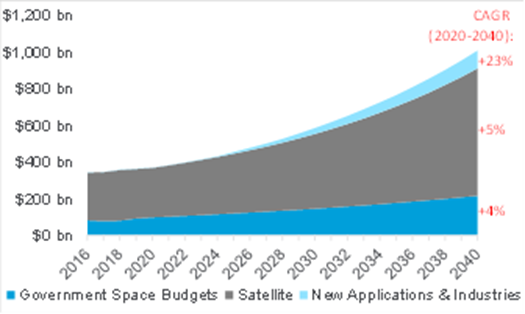
Space is the ultimate high ground.
It’s vital for intelligence agencies. And it’s a vital domain in warfare.
It also provides an ideal perch from which to collect data for use on earth. That data has myriad potential uses, from mapping to asset and crop monitoring, weather forecasting to climate change tracking.
And of course it hosts the satellites that facilitate our ability to communicate.
In the future, according to the new Citi research report, we’ll likely see increased discussion of space-based solar power, Moon/asteroid mining, space logistics/cargo, space tourism, inter-city rocket travel, and areas such as microgravity R&D and construction.
Citi published a GPS report in mid-2022 that forecasts space to become a trillion-dollar industry by 2040 (a 5% CAGR) propelled by growth across the satellite industry, government space budgets, and a proliferation of new applications and industries.
Space Economy in 2040

Source: Citi Research, Satellite Industry Association (2016-20)
Mix of Space Economy in 2040
Source: Citi Research (2040), Satellite Industry Association (2020)
That a level of growth that’s in line with the defense industrial base and the commercial aerospace ecosystem over the coming decade. That said, there are clear pockets of near-term growth that will exceed these levels, including the ramp in spending currently forecast by DoD in the United States, e.g., 20% y/y growth in space-related spending in FY24.
The science of designing survivable spacecraft is hard. Delays are frequent. As we’ve seen recently, rockets can explode shortly after or during launch.
Once in orbit, failures are nearly impossible to fix, and successfully deployed assets have finite lives given the limitations of fuel and the harsh environment in which they operate (e.g., radiation).
And the cost of deploying space-based hardware is high – even if it is falling. This means that revenue visibility must be high from day one of deployment to provide for the opportunity to earn a decent return.
Governments, the report says, will be the enduring customer base for the space industry.
Nation-states, it says, have the combination of security needs and the economic wherewithal to buy and operate space-based assets and / or to buy services derived from them by commercial providers. In our view, companies that do not focus on government markets are likely to have less revenue visibility up front, which is a risky proposition given the finite lives of the assets being deployed.
In recent years, dozens of companies active in the space market have either started operations or have gone public.
In some cases, business plans were not fully funded, either by design as companies proceeded through various private rounds or as investor appetite waned in the SPAC market, leading to high redemption rates.
Meanwhile, some are struggling to ramp revenue as quickly as projected as product / market fit was off or the timing of customer adoption has been slow. And still with others, technical milestones have proven tricky to achieve.
All this suggests that a shakeout is likely, with some companies chasing the market prone to fail and others to be absorbed by larger, better funded organizations within this big, and growing sector.
For more information on this subject, please see US Aerospace & Defence - Space: How to invest in today’s Goldrush (17 April 2023)
Citi Global Insights (CGI) is Citi’s premier non-independent thought leadership curation. It is not investment research; however, it may contain thematic content previously expressed in an Independent Research report. For the full CGI disclosure, click here.